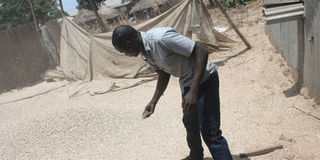Electric power from groundnut shells

Joseph Odongkara, a dealer in groundnut shells, says it is lucrative business. PHOTO BY STEPHEN OKELLO
What you need to know:
- Groundnut shells, one of the biggest food industry waste products, could be used to generate environment friendly biomass electricity, writes Stephen Okello
For years groundnut shells have been levying serious burden to business people who were using a machine to remove the groundnut shell in Gulu District because they failed to have specific gazetted place to damp the trash that is produced in large volume.
David Olobo, a cleaner in Cherulleno Market, says at one time, the Municipal Council threatened to evict them from the market following complaints from the neighbourhood on the litter from the shells. This forced many traders to devise means of disposing of the shells. One of those interventions became the generation of electricity.
Olobo says, “The story has turned around as groundnut shells have become a lucrative business with those who have discovered its potential searching far and wide for it.”
He says several factories have started buying the shells to generate power to run the factories.
Usage in the factory
According Moses Obbo, a factory worker, the shells are burnt in the waste incineration plants to generate superheated steam in boilers, and the steam is in turn used to drive turbo generators to produce biomass electricity that runs the machine plant in the factory.
Biomass power is carbon neutral electricity generated from renewable organic waste that would otherwise be dumped in landfills, openly burned, or left as fodder for forest fires. When burnt, the energy in biomass is released as heat.
He said the groundnut shells are in high demand in factories because biomass electricity is cheaper than hydroelectricity yet serves the same purpose.
“The factory runs all day long so we have to look from different parts of the country,” adding that the renewable energy source from groundnut shells has proved to be an effective backup for power cuts.
The shells are poured into a boiler and left for an hour to heat until it produces steam.
It is the steam produced that acts like fuel (biomass electricity) and is used to drive the turbo generator to run the factory machines.
Josephs Odongkara, a manager at Walters Machine in Gulu Industrial Area, says the demand for shells started in 2014. He says as processors for groundnuts they were more than happy to give away shells to whoever needed them.
“At first we were giving out the shells for free because we were saving on money we would otherwise have spent on ferrying the shells to the district dumping site. But when we realised that our wastes were being used as a relief aid in factories we started charging.”
The factory started asking for Shs20,000 per trip to meet loading and offloading costs. However, as the demand for the shells went up the monies were revised and they now charge Shs80,000.
Other uses
After harvesting and de-hulling, the ground shells are separated from nut, accounting for approximately 20 per cent of the dried peanut pod by weight, which means a substantial amount of shell residual biomass left after processing. Peanut shells or hulls are used as cattle feed, poultry litter and garden mulch and now they are seen as potential fuel source.
Scientists in Canada created a hybrid sodium ion capacitor (NIC) from peanut shells in a pioneering study bridging the gap between conventional ion batteries and supercapacitors.
In Gulu District, some farmers use the shells for mulching.
Left behind
Olobo says despite the increased demand of shells most groundnut farmers in northern Uganda do not have the information on this new market opportunity. Francis Abonga a farmer from Nwoya District urges factory owners to sensitise farmers on this initiative so that they too can understand how to preserve husks.
Did you know
Peanut shells are used as cattle feed, poultry litter and garden mulch and now they are seen as potential fuel source.
Peanut and peanut shell
The nut cracker.
Peanuts, also known as groundnuts, earthnuts, ground-peas, manila-nut, jar-nut, are pea-like fruit from Arachis hypogaea plant. There are various types of peanuts available around the world distinguished by branching habit and branch length. Even though there are numerous varieties of peanuts, there are two main growth forms , the bunch and runner.Energy generation
Jimmy Ghali, a factory owner, says in order to make the best of groundnut husks and develop a new energy source, the husks can be compressed into fuel pellets with a peanut shell or hull pellet mill. There are two types peanut shell pellet mills, the flat die sort and the ring die sort. The former is usually used for small scale pellet production, favored by household users, and farmers, and small business pellet producers while the latter is used for large scale pellet produced, used by medium and large scale pellet producers for large scale boilers and power generations.“After pelletising, the moisture content of the husk will be lowered significantly and the bulk density will be increased from 151 kg/m(3) to more than 600 kg/m(3). What needs to mention is the peanut pellet density and bulk density are largely affected by moisture content attained by the pellets during exposure to the low or high humidity environment,” he says. Compiled by Alice Adikin




